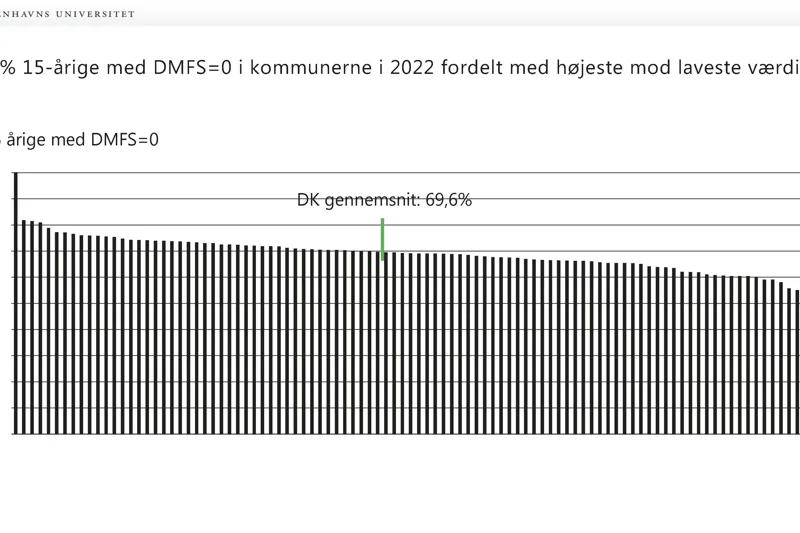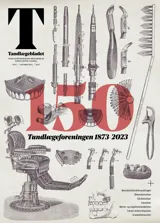Carieserfaringen i børne- og ungdomstandplejen i Danmark fra 1972-2022. En narrativ fortolkning af succesen
Denne originalartikel illustrerer forbedringer i carieserfaringen udtrykt hos børn og unge fra 1972/73 og diskuterer, hvilke initiativer der mest sandsynligt har haft størst indflydelse på udviklingen.

Baggrund – Folketinget vedtog ved lov i 1971, at kommunerne skulle indføre gratis og opsøgende tandpleje for skolebørn i Danmark.
Formål – At illustrere de forbedringer i carieserfaringen udtrykt igennem defs/DMFS på syv- og 15-årige i perioden over 50 år fra 1972-2022 og diskutere, hvilke initiativer der mest sandsynligt har haft størst indflydelse på udviklingen.
Materiale og metode – Både tværsnit og kohortecariesdata for syv- og 15-årige er indsamlet fra SCOR-systemet fra 1972 og frem. Relevante kliniske studier er sporet fra Tandlægebladets arkiv og fra Tandlægernes Nye Tidsskrift suppleret med international litteratur.
Resultater – Gennemsnitlig defs på syvårige var i 1972/73 12,5, faldende til 6,6 i 1992 og videre til 1,78 i 2022. På 15-årige var den gennemsnitlige DMFS i 1982/83 11,4 faldende til 4,36 i 1992 til 1,02 i 2022. Cariestilvæksten på kohorteniveau målt for tre-, fem- og syvårige (defs, kohorte a-d) og på 7-15-årige (DMFS, kohorte A-F) faldt markant fra 1972/73 til 2022. Litteraturen indikerer, at specielt 1) etablering af tandplejeordningen i 1972 og dens udvidelse over årene, 2) den kontinuerlige fokusering på kvalitetstandbørstning, 3) brug af fluoridholdige produkter, 4) brug af fissurforseglinger med ændret syn på, hvornår fyldningsterapi skal udføres og 5) cariesrisikorelaterede programmer ud fra individuelle behov, fx Nexø-metoden og Odder-modellen, alle har haft en markant effekt på den opnåede cariesreduktion.
Konklusion – Ovennævnte faktorer har med stor sandsynlighed bidraget til at reducere carieserfaringen fra at være ekstremt høj til ekstremt lav over 50 år.
Klinisk relevans:
Cariesprævalensen blandt danske børn og unge var i 1960’erne uacceptabelt høj og blandt de højeste i verden. Folketinget besluttede sig i 1971 for på nationalt niveau at etablere gratis tandpleje først kun for skolebørn så på børn og unge fra 0 til 18 år. Tandplejeordningens lovmæssige opsøgende karakter, årlige undersøgelser og registreringspligt af målgruppens orale status og anvendelse af cariesforebyggende metoder baseret på forskningsresultater fra studier primært udført på børn og unge i Danmark har resulteret i, at danske børn og unge i dag har, hvis ikke den laveste, så blandt de laveste cariesprævalenser i verden. Grundet SCOR, udviklet af Helm og medarbejdere i starten af 1970’erne (3), kan data i Danmark udtrykkes på populationsniveau, eksempelvis at 70 % af 15-årige i Danmark i 2022 har et DMFS = 0, og kun ca. 5 % har et DMFS > 4.
The caries experience in child and adolescents dental care in Denmark from 1972 to 2022. A narrative interpretation of success
Background – The Danish parliament passed by law in 1971 that the municipalities should introduce free outreach dental care for school children in Denmark.
Purpose – To illustrate the improvements in caries experience expressed through defs/DMFS of 7- and 15-year-olds in the period over 50 years from 1972-2022 and to discuss which initiatives have most likely had the greatest influence on the development.
Material and method – Both cross-sectional and cohort caries data for 7- and 15-year-olds have been collected from the registration system of the oral status of children and adolescents, which the Danish National Board of Health collects yearly from all the municipalities in Denmark. Relevant clinical studies are traced from Danish dental journals, supplemented with international literature.
Results – Average defs in 7-year-olds was 12.5 in 1972/73, falling to 6.6 in 1992 and to 1.78 in 2022. In 15-year-olds, the average DMFS in 1982/83 was 11.4, falling to 4 .36 in 1992 to 1.02 in 2022. Caries growth at cohort level measured for 3-5-7-year-olds (defs, cohorts a-d) and for 7-15- year-olds (DMFS, cohorts A-F) fell significantly from 1972/73 to 2022. The literature indicates that especially 1) the establishment of the dental care scheme in 1972 and its expansion over the years, 2) the continuous focus on quality toothbrushing, 3) use of fluoride-containing products, 4) use of fissure sealants with the changed views on when filling therapy should be performed. and 5) caries riskrelated programs, according to individual needs, e.g. The Nexø method and the Odder model have all had a significant effect on the caries reduction achieved.
Conclusion – The above-mentioned factors have very likely contributed to reducing caries experience from being extremely high to extremely low over 50 years.


